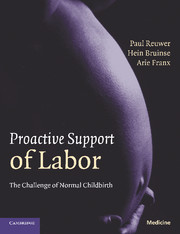Book contents
- Frontmatter
- Contents
- Foreword
- Acknowledgments
- Web-Forum
- 1 General introduction
- Section 1 A wake-up call
- 2 Medical excess in normal childbirth
- 3 Iatrogenic causes of failed labors
- 4 Harmful birth care practices
- 5 Destructive territorial disputes
- 6 Self-sustaining mechanisms
- Section 2 Back to basics
- Section 3 Proactive support of labor
- Index
- References
5 - Destructive territorial disputes
Published online by Cambridge University Press: 08 September 2009
- Frontmatter
- Contents
- Foreword
- Acknowledgments
- Web-Forum
- 1 General introduction
- Section 1 A wake-up call
- 2 Medical excess in normal childbirth
- 3 Iatrogenic causes of failed labors
- 4 Harmful birth care practices
- 5 Destructive territorial disputes
- 6 Self-sustaining mechanisms
- Section 2 Back to basics
- Section 3 Proactive support of labor
- Index
- References
Summary
Women's critique of the excessive medicalization and related “dehumanization” of childbirth has led to calls for the return of independent midwifery care and even home births. The question is whether this post-modern trend will provide proper solutions. Answers can be found by examining western childbirth systems that formally include autonomous midwifery care. In this context some fundamental differences between midwifery care and the medical approach must be illuminated. Strong prejudices and emotions are involved here and disputes are often characterized more by heat than by light: the debate is usually about choice of caregiver and place of birth, rather than about labor.
Controversial birth philosophies
Unlike obstetricians and hospital managers, who generally see childbirth as a standard medical problem subject to the modern paradigm of “managed care,” midwives typically approach labor and delivery as a natural process and a highly individual experience, sometimes even compounded with a spiritual, nigh-mystical atmosphere. An exemplary quote: “[labor,] … it is predictable that it will occur, but unpredictable and idiosyncratic in its actual occurrence. Despite attempts to package labor into discrete phases and stages, it is better understood as a whole, with an ebb and flow and rhythms of its own. It is intensely physical and emotional, consuming all of one's attention and energy; yet life-giving and empowering in that intensity. How then is it possible to ‘manage’ labor?”
- Type
- Chapter
- Information
- Proactive Support of LaborThe Challenge of Normal Childbirth, pp. 35 - 41Publisher: Cambridge University PressPrint publication year: 2009



